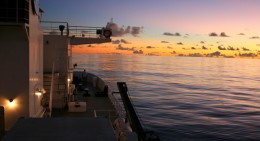The University of Hawaiʻi has hit a major milestone in its critical research to observe and understand how the ocean responds to climate change.

On February 28, 2018, UH’s research vessel Kilo Moana returned from its 300th scientific expedition of the Hawaiʻi Ocean Time-series (HOT) program. Completion of 300 research cruises makes Station ALOHA, about 60 miles north of Oʻahu, one of the best-sampled places in the world’s oceans with a decades-long record of how the ocean responds to climate change.
UH has undertaken almost monthly research cruises for 30 years to the same observation area to observe and interpret habitat variability, and to observe and understand the impacts of climate variability and change on the marine ecosystem.
“It is really satisfying to reach this milestone, and to see the growing importance of the HOT program accomplishments,” said David Karl, UH oceanography professor and co-director of the Simons Collaboration on Ocean Processes and Ecology. “Here we are at 30 years and counting. Each additional year of observations brings us closer to a fundamental understanding of how the ocean functions, and its relationships to climate.”
Invaluable documentation on progressive ocean acidification

On November 3, 1988, the scientists and crew aboard UH research vessel Moana Wave successfully established a deep ocean observation station dubbed ALOHA (A Long-term Oligotrophic Habitat Assessment) as the benchmark site for the HOT program. Karl and Roger Lukas, who at the time were both professors of oceanography in UH’s newly created School of Ocean and Earth Science and Technology (SOEST), led the expedition.
The primary objective of HOT was to obtain a long-term time-series of physical, biological and chemical observations at a location that was characteristic of the North Pacific Subtropical Gyre habitat to address U.S. Global Change Research Program goals—to document and understand variability of ocean water masses and circulation; to determine the relationships between microbial community structure and function, including nutrient dynamics and carbon sequestration; and to measure carbon dioxide in upper ocean and changes in the capacity of the ocean to absorb it.
“Observing the ocean carefully, consistently, frequently and long enough to capture important modes of variability is very hard work that is occasionally rewarded with fundamental discoveries,” said Lukas, now a UH oceanography emeritus professor.
In addition to the monthly ship-based observations, HOT program scientists have access to real-time satellite-based remote observations, unattended mooring measurements, autonomous instrumented gliders and floats, and a cabled seafloor observatory with power and fiber optic internet connections back to Oʻahu. This has provided invaluable documentation on progressive ocean acidification, changes in seawater temperatures, and changes in plankton biodiversity.
“The HOT program is providing new understanding of fundamental ocean processes, even as those processes are being modified by human activities on a global scale,” said SOEST Dean Brian Taylor. “It is essential to skillfully continue the HOT observations, experiments, data analysis and student training that we may monitor, and inform society how best to respond to, the changing ocean conditions.”
HOT program is UH’s floating classroom
In addition to its primary mission of ocean research, the HOT program has been an invaluable training ground for undergraduate and graduate students as “UH’s floating classroom,” Karl said. “Several of our former students, and their students, are now involved in HOT program research—so the HOT influence has now extended into the next generation of marine scientists.”
The success of the HOT program, to date, is a result of the coordinated, dedicated efforts of a large team of academic scientists, marine technicians and engineers, and the professional crews of the research vessels.
The HOT program receives primary funding from the U.S. National Science Foundation in partnership with the Simons Foundation, the Gordon and Betty Moore Foundation and the State of Hawaiʻi.
—By Marcie Grabowski

